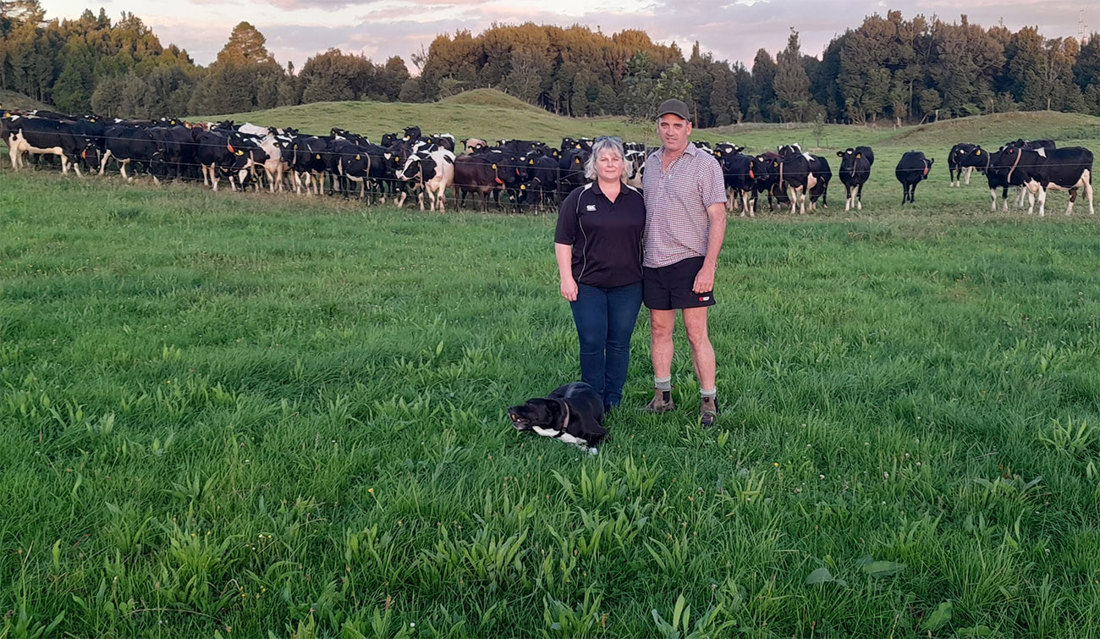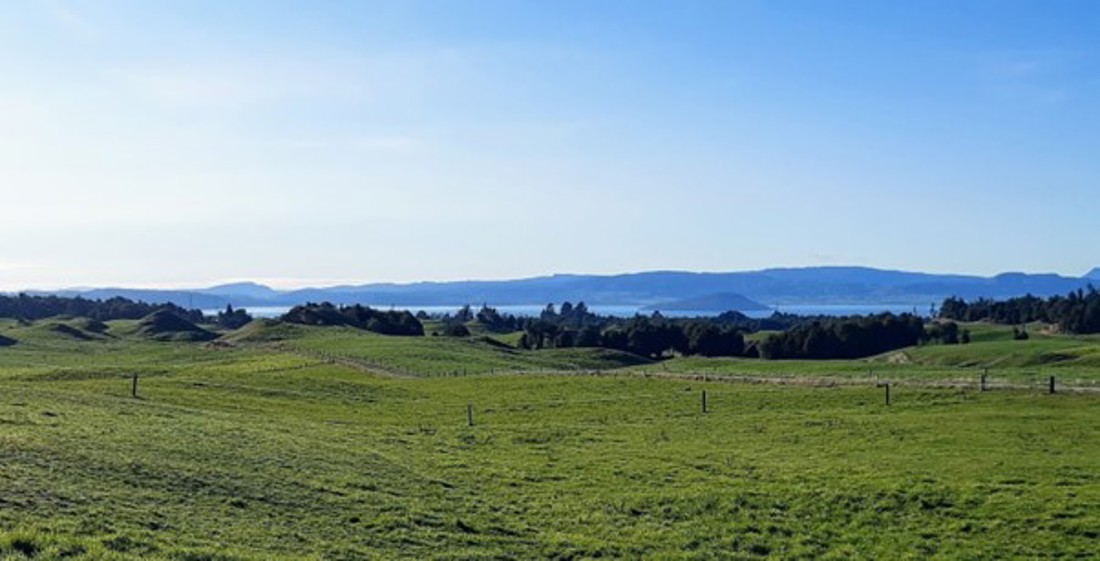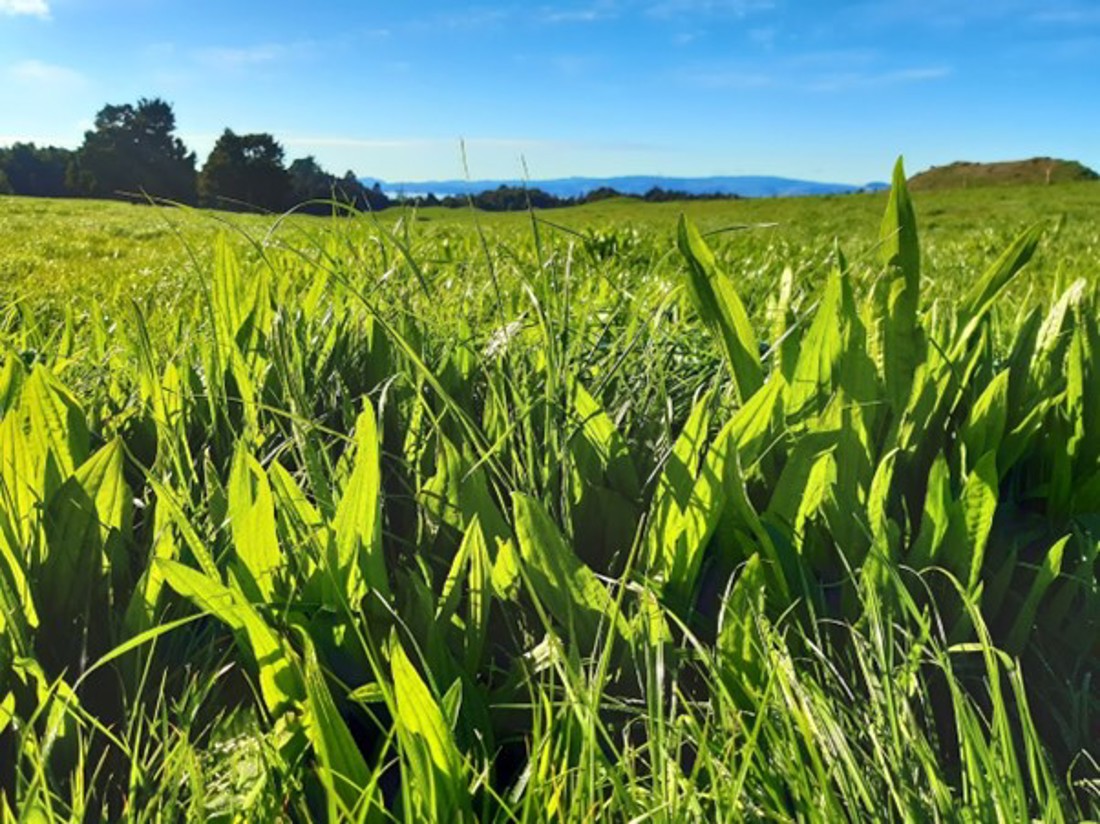Plantain partner farm, Steve and Paula Holdem (Rotorua)
6 min read
The page provides a real-life example of how to grow plantain and details its effectiveness, both as part of dairy farm management and to reduce the environmental footprint. Steve and Paula Holdem operate a 265 effective hectare dairy farm on the Mamaku plateau, overlooking Lake Rotorua. The Holdems have successfully incorporated plantain across most of their farm by broadcasting seed with their fertiliser and reduced the farms' environmental footprint.
Farming in the Lake Rotorua catchment means meeting challenging N-loss targets. Knowing they had to do their bit for the environment, Steve and Paula Holdem began looking at tools to reduce their N-loss from their farm.
In 2018 they started incorporating plantain into their farm system. By 2023, there was plantain present across 92% of the milking platform of Holdem Farm.

Steve and Paula Holdem
Steve and Paula Holdem farm on the Mamaku plateau, overlooking Lake Rotorua. They operate a 265 effective hectare dairy farm, which they bought with Steve’s parents, Jeff and Glenys in 2017. The Holdem’s have been using plantain since, as it helps them run a profitable farm system while caring for the environment and building a sustainable future.
Farm size (effective)
265ha
Soil class
Podzol (well-drained)
Topography
Flat to rolling
Annual rainfall
2,050mm/year
Average annual temperature
12 degrees C
Herd size and breed
700 crossbred
Stocking rate
2.7 cows/effective ha
Milksolids production (4-year average)
408 kg MS/cow
Milksolids production (4-year average)
1,087 kg MS/ha
Farm system class
System 3
Purchased feed
350 t DM maize silage and 350 t DM PKE
Holdem Farm falls under the regional council rules for the Lake Rotorua catchment. Steve and Paula are required to achieve a 29% N-loss reduction by 2032, down to 41 kg N/ha/year. The average N-loss reduction required for the Lake Rotorua catchment is 35%.
As part of the partner farm project, three scenarios were modelled that achieve the target N-loss for Holdem Farm. The base farm model includes young stock and cows wintered within the system and no plantain use.
Scenario 1: Plantain +
Scenario 2: Fewer cows
Scenario 3: Stand-off pad
Table 1. Modelled N-loss scenarios for Holdem Farm
| Base (2021/22 season) |
Scenario 1 (plantain) | Scenario 2 (fewer cows) | Scenario 3 (stand-off pad) | |
| Production (kg MS/year) | 299,552 | 267,702 | 205,296 | 275,764 |
| Stocking rate (cows/ha) | 2.1 | 2.1 | 1.9 | 1.4 |
| N fertiliser to pasture (kg/ha) | 99 | 92 | 92 | 76 |
| Pasture conserved (t DM/year) | 146 | 315 | 1096 | 222 |
| Total N loss (kg N/year) | 23,271 | 15,912 | 16,031 | 16,077 |
| N leached (kg/ha/year) | 60 | 41 | 41 | 41 |
| N surplus (kg/ha/year) | 174 | 148 | 111 | 146 |
| Purchased N surplus (kg/ha/year) | 73 | 41 | -2 | 24 |
| Operating profit ($/ha) | $4,019 | $3,864 (-4%) | $3,631 (-10%) | $3,354 (-17%) |
| Methane (t CO2 eq./ha) | 6.26 | 6.44 | 4.99 | 5.96 |
| Nitrous oxide (t CO2 eq./ha) | 1.86 | 1.59 | 1.41 | 1.47 |
1Modelled in Farmax, based on DairyBase data.
Regrassing is not a common practice for the Holdem’s, so Steve and Paula mostly incorporate plantain by spreading the seed with their fertiliser. They started off by doing this at a rate of 8 kg/ha (4 kg/ha equivalent bare seed), with 100 ha of the farm broadcast with Ecotain seed in 2018/19. Over the following year, plantain was broadcast across the rest of the farm and some areas were undersown with 2 kg/ha of bare Ecotain seed.
Over time the Holdem’s saw plantain content decrease across their farm. To maintain plantain, the Holdem’s now broadcast 4 kg of coated Ecotain seed per hectare with their fertiliser. This has allowed the Holdem’s to achieve plantain presence across 92% of their platform.
The Holdem’s have found plantain grows better in less fertile areas.
If you have areas of the farm that the fertiliser doesn’t get to very often, plantain grows really well there.
Steve Holdem, Farm Owner
Using plantain has been very simple and easy for the Holdem’s – “it just grows” Steve says. The Holdem’s haven’t had to make any changes to their farm system to manage the plantain, although it has required some patience.
Steve says farmers looking to incorporate plantain into their system need to have realistic expectations around establishing plantain, and its lifespan. Although they sometimes see spring-sown seed growing by the following autumn, the Holdem’s have found that it generally takes a full season to see the plantain after the seed is broadcasted.
“Be patient,” says Steve. “Don’t expect it to be there in six months. And it won’t be there forever, you have to keep topping it up every year or two.”



Using plantain is an attractive N-loss mitigation tool for the Holdem’s when compared with the effects that reducing their herd by 200 cows would have on their business. They have reduced their N-loss by 12% in OverseerFM through using plantain, while increasing their milk production, achieving over 300,000 kg MS in the 2020/21 season.
Using plantain, we can maintain a higher stocking rate, higher production and higher profit. Without plantain, we would have to drop our stocking rate, with lower production and profit. That makes the $40 per hectare seed cost a good investment.
Steve Holdem, Farm Owner
Steve and Paula find that during the long summers, plantain is a reliable feed source on their farm and it consistently out-performs ryegrass in the right conditions. “Pastures with plantain are first to recover after a dry spell,” Steve says.
Rotorua farm owner Steve Holdem joins us to share his experience with Ecotain plantain: what’s worked well, what he and wife Paula have learned about maintaining it, and how it’s saving them from reducing their stocking numbers. Also on the podcast is DairyNZ’s Kate Fransen, who’ll give a clear overview of what a decade’s research has taught us about plantain. New results show even better than expected leaching reductions can be achieved.
Now’s the perfect time to check in, plan, and set up for a strong season. We’ve pulled together smart tips and tools to help you stay ahead all winter long.
Whether you prefer to read, listen, or download handy guides, we’ve got you covered with trusted tools to support your journey every step of the way.
Put our proven strategies and seasonal tools to work. Boost production, support animal health and watch your profits hum.
Tools that are backed by science, shaped by farmers and made for this season.
That’s Summer Smarts.